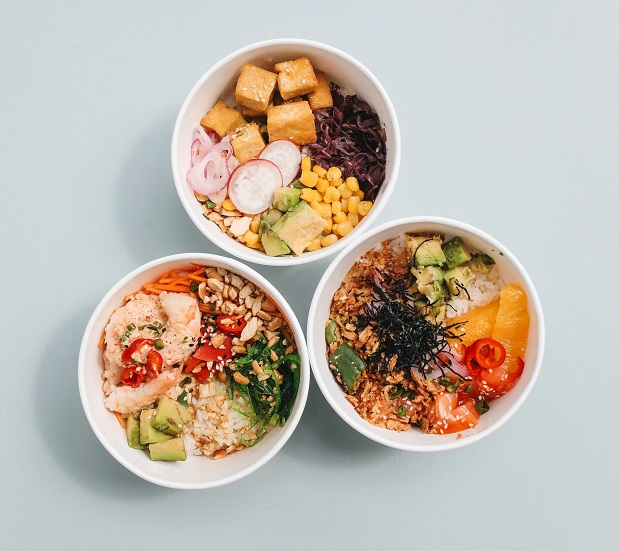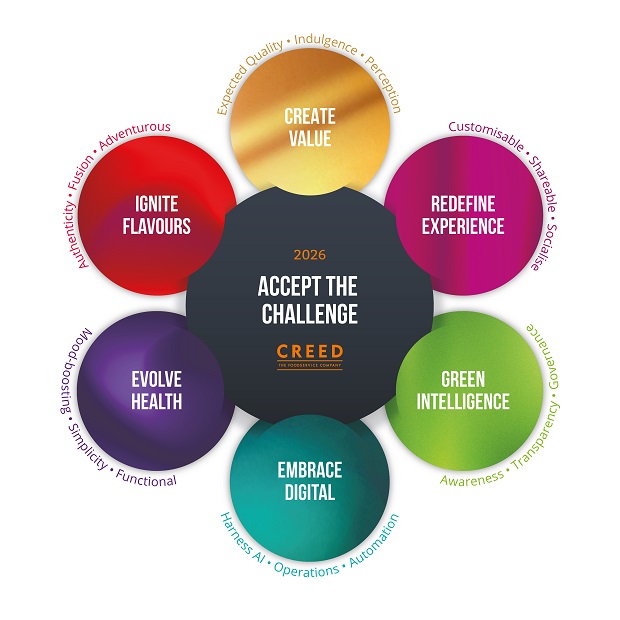A bold call to action for operators to lead with innovation, value and purpose
 Creed Foodservice, one of the UK’s leading foodservice providers, has launched its 2026 Trends Report, setting a bold agenda for the hospitality industry as it navigates another year of change and challenge, but also opportunity. Drawing on expert analysis, consumer insight, and practical experience, the report identifies six key micro trends shaping the UK’s out-of-home food and drink landscape – from digital disruption and economic pressure, to flavour exploration and wellness priorities.
Creed Foodservice, one of the UK’s leading foodservice providers, has launched its 2026 Trends Report, setting a bold agenda for the hospitality industry as it navigates another year of change and challenge, but also opportunity. Drawing on expert analysis, consumer insight, and practical experience, the report identifies six key micro trends shaping the UK’s out-of-home food and drink landscape – from digital disruption and economic pressure, to flavour exploration and wellness priorities.
 This report goes beyond trendspotting – it’s a strategic tool for chefs, operators, and hospitality leaders continuing to navigate tight margins and evolving customer expectations. With data-backed insights, real-life examples from UK operators, and actionable takeaways, it offers a clear guide for menu development, marketing, and experience creation in 2026.
This report goes beyond trendspotting – it’s a strategic tool for chefs, operators, and hospitality leaders continuing to navigate tight margins and evolving customer expectations. With data-backed insights, real-life examples from UK operators, and actionable takeaways, it offers a clear guide for menu development, marketing, and experience creation in 2026.
Macro Trend for 2026: Accept the Challenge
The UK’s hospitality sector stands at a crossroads. With consumer behaviour still reactive, strong economic headwinds lingering, and expectations rising, operators must continue to adapt with both purpose and precision. Businesses need to move from just managing pressure to leading innovation.
Gabrielle Evans, Insights Executive at Creed Foodservice, commented on the backdrop to the 2026 trends report and what Creed is trying to achieve: “In 2026 the challenge isn’t just to endure, but to survive, thrive and lead the change with agility and bold thinking. Our mission is to empower operators with real insight and creative inspiration. This report is our rallying call for operators to Accept the Challenge.”
Six Micro Trends Shaping the Out-of-Home Market in 2026
- Create Value: Consumers define value as more than just price – it’s about emotional reward, fairness and perceived quality. Affordable indulgences and premium comfort food that justifies the cost will dominate. Pizza Express’ Pizzanaise, a new exclusive dip, is a good example of a small product innovation that adds value to the customer without reinventing the whole menu. Greggs are also focussing on bringing value to their customers through its Rewards+ app which gives the user price deals and freebies based on their purchasing habits, tapping into instant gratification.
- Redefine Experience: Dining is about more than just food, it’s driven by our need for connection through experiences with friends and family. Operators are investing in social-first dishes, immersive environments, and hybrid spaces that combine function with feeling, to satisfy customers who are looking for more than just a straightforward meal. Dishoom have fully embraced this move towards the experiential with Storytelling Evenings where themed dinners are brought to life with narration and music.
- Green Intelligence: Sustainability is no longer just a buzz word and has matured into measurable accountability, with social governance keeping it in check. Now an expectation from consumers, transparency of practices is key to show that what is being preached is being practiced. Brands like Wahaca are leading the way with this by making conscious decisions about their ingredient sourcing – the brand exclusively uses British regenerative beef and Marine Stewardship Council (MSC) certified seafood, and proudly states this on its menus. Compass Group is putting live carbon labelling on menus to help consumers choose dishes with the environment in mind. Whilst LEON is investing in chef training for young people – showing that sustainable practices can have a social focus and be more than just about the food.
- Embrace Digital: Tech is the invisible engine behind modern hospitality. But, whilst robot baristas and AI-powered menu suggestions are the future, essential technology for operators to embrace in the here and now centres around social media which drives discovery of venues and dishes – sometimes at speed – thanks to food trends turning into viral sensations overnight. Digital tools are also transforming team efficiency and guest experience alike with things like virtual training technologies and self-serve kiosks. Popeyes is an example of a brand taking it to the next level, using an AI voice assistant which understands regional British accents in its drive-thru lanes, whilst McDonald’s have a ‘MyMaccy’ pilot running which offers hyper-personalised menus based on the weather and time of the day.
- Evolve Health: Health continues to move beyond low-calorie and high protein options into functional, feel-good eating. Expect more demand for gut health, fibre-focussed meals, and mood-boosting ingredients to grow across all sectors and with all demographics. Brother Marcus is an example of an operator championing whole foods, with their menus centred around Mediterranean dishes that are packed with seasonally sourced vegetables and other high-quality ingredients. The brand’s work with industry standard bodies like the Sustainable Restaurant Association and WRAP is becoming a blueprint for others who are looking to take a similar approach to their offering.
- Ignite Flavours: Consumers crave flavour fusion – bold twists on nostalgic favourites, regional cuisine celebrations, and story-driven dishes that blend authenticity with excitement. Seeking adventure through eating, many are looking for global influences from Central and South America – Mexico and Peru, Korea and the Italian regions of Calabria and Sicily. Nando’s is embracing this with its ‘Peri-Global’ series, a selection of limited-edition sauces that blend the peri-peri classics with flavours like Korean gochujang and Mexican habanero. The ‘Global Comfort Menu’ from Bill’s is a heady mix of global flavours and nostalgic British dish fusions – think Thai-spiced shepherd’s pie and harissa mac n cheese.
Adopting and Implementing the Microtrends
All of these microtrends can be dialled up or down to suit individual businesses. It’s not about trying to do everything, if operators can understand their customer base, they can identify which trends are a priority to them and make choices that deliver maximum impact.
Being aware of generational drivers can help operators tailor their offer to their audience. Influenced by distinct values, lived experiences and spending habits, dining priorities can be generalised by age. At the top, Baby Boomers tend to seek familiarity and quality in their meal choices, conscious about their health and aging concerns, they are less focussed on sustainability. Generation X, are also a quality driven group, but they look for greater convenience by embracing digital innovations. Willing to try new flavours and cuisines they are somewhat experimental but also remain loyal to dishes and cuisines that they know they enjoy. Millennials view food with a blend of practicality and indulgence, prioritising high quality ingredients and strong provenance stories. They are less tied to the traditional three dayparts and instead snack regularly. Whilst Generation Alpha, the ‘AI Native’ generation expect everything on-demand, looking for hyper-convenience.
Rob Owen, Executive Business Development Chef at Creed, said: “Food innovation can feel like an overwhelming task for operators, but it doesn’t have to mean reinventing the wheel. Small changes with smart thinking can unlock big wins for businesses in this climate. Innovating around the edges, for example, lifting a dish from good to amazing with some knock-out sauces and sides, as well as making it really visually appealing can draw the consumer in and give them a sense of value.”
To download the full 2026 Creed Trends Report and explore how Creed can support menu and operational innovation, visit: about.creedfoodservice.co.uk/insights-reports-trends/.
For a free 1-1 Trends Insights Consultation with Creed Insights Executive, Gabrielle Evans, register here: www.about.creedfoodservice.co.uk/insights-121/.




Comments are closed.